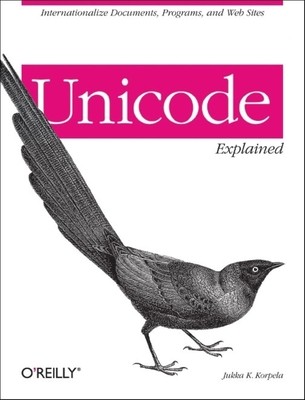
- We will send in 10–14 business days.
- Author: Jukka K Korpela
- Publisher: O'Reilly Media
- ISBN-10: 059610121X
- ISBN-13: 9780596101213
- Format: 18 x 23.3 x 3.2 cm, softcover
- Language: English
- SAVE -10% with code: EXTRA
Reviews
Description
Fundamentally, computers just deal with numbers. They store letters and other characters by assigning a number for each one. There are hundreds of different encoding systems for mapping characters to numbers, but Unicode promises a single mapping. Unicode enables a single software product or website to be targeted across multiple platforms, languages and countries without re-engineering. It's no wonder that industry giants like Apple, Hewlett-Packard, IBM andMicrosoft have all adopted Unicode.
Containing everything you need to understand Unicode, this comprehensive reference from O'Reilly takes you on a detailed guide through the complex character world. For starters, it explains how to identify and classify characters - whether they're common, uncommon, or exotic. It then shows you how to type them, utilize their properties, and process character data in a robust manner.
The book is broken up into three distinct parts. The first few chapters provide you with a tutorial presentation of Unicode and character data. It gives you a firm grasp of the terminology you need to reference various components, including character sets, fonts and encodings, glyphs and character repertoires.
The middle section offers more detailed information about using Unicode and other character codes. It explains the principles and methods of defining character codes, describes some of the widely used codes, and presents code conversion techniques. It also discusses properties of characters, collation and sorting, line breaking rules and Unicode encodings. The final four chapters cover more advanced material, suchas programming to support Unicode.
You simply can't afford to be without the nuggets of valuable information detailed in Unicode Explained.
EXTRA 10 % discount with code: EXTRA
The promotion ends in 19d.14:48:07
The discount code is valid when purchasing from 10 €. Discounts do not stack.
- Author: Jukka K Korpela
- Publisher: O'Reilly Media
- ISBN-10: 059610121X
- ISBN-13: 9780596101213
- Format: 18 x 23.3 x 3.2 cm, softcover
- Language: English English
Fundamentally, computers just deal with numbers. They store letters and other characters by assigning a number for each one. There are hundreds of different encoding systems for mapping characters to numbers, but Unicode promises a single mapping. Unicode enables a single software product or website to be targeted across multiple platforms, languages and countries without re-engineering. It's no wonder that industry giants like Apple, Hewlett-Packard, IBM andMicrosoft have all adopted Unicode.
Containing everything you need to understand Unicode, this comprehensive reference from O'Reilly takes you on a detailed guide through the complex character world. For starters, it explains how to identify and classify characters - whether they're common, uncommon, or exotic. It then shows you how to type them, utilize their properties, and process character data in a robust manner.
The book is broken up into three distinct parts. The first few chapters provide you with a tutorial presentation of Unicode and character data. It gives you a firm grasp of the terminology you need to reference various components, including character sets, fonts and encodings, glyphs and character repertoires.
The middle section offers more detailed information about using Unicode and other character codes. It explains the principles and methods of defining character codes, describes some of the widely used codes, and presents code conversion techniques. It also discusses properties of characters, collation and sorting, line breaking rules and Unicode encodings. The final four chapters cover more advanced material, suchas programming to support Unicode.
You simply can't afford to be without the nuggets of valuable information detailed in Unicode Explained.


Reviews